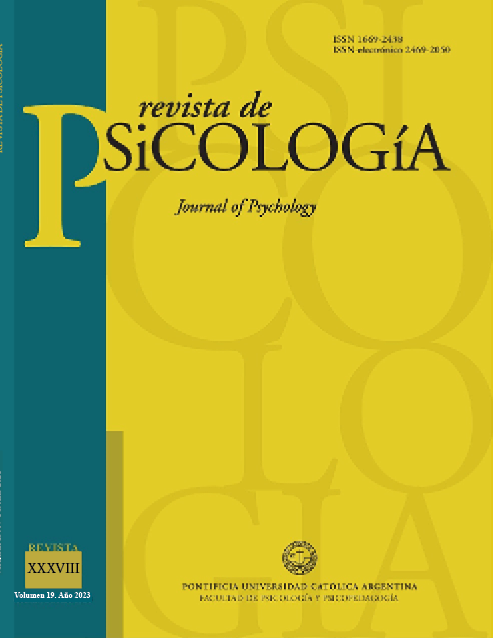Comportamiento Autolesivo en la Adolescencia y Neuropsicología: Revisión Integrativa de 2015 a 2022
DOI:
https://doi.org/10.46553/RPSI.19.38.2023.p41-62Palabras clave:
Desarrollo del Adolescente, Conducta Autodestructiva, Conducta autolesiva, Neuropsicología, Regulación EmocionalResumen
El desarrollo esperado en la adolescencia pasa por el fortalecimiento de la regulación emocional y la adecuación de las funciones ejecutivas vinculadas al desempeño de la corteza prefrontal. En cambio, la perturbación de este proceso hace referencia a la desregulación emocional, común en la mayoría de las psicopatologías o conductas de riesgo, como la autolesión. Esto es una revisión integradora de la literatura sobre aspectos neuropsicológicos vinculados a las autolesiones no suicidas. Las búsquedas se realizaron en el Portal CAPES y en la base de datos Google Scholar. Se encontraron 487 estudios, 14 de los cuales son elegibles para esta revisión. Se observaron asociaciones de la conducta autolesiva con alteraciones en el campo de la regulación emocional, y conducta suicida.
Descargas
Citas
Andover, M. S., Wren, A., Schatten, H. T., Morris, B. W., Shashoua, M. Y., & Holman, C. S. (2015). Non-suicidal self-injury. In T. P. Gullotta, R. W. Plant, & M. A. Evans (Eds.), Handbook of adolescent behavioral problems: Evidence-based approaches to prevention and treatment (pp. 631–648). Springer Science + Business Media. https://doi.org/10.1007/978-1-4899-7497-6_33
Ammerman, B. A., Jacobucci, R., Kleiman, E. M., Uyeji, L. L., & McCloskey, M. S. (2018). The Relationship Between Nonsuicidal Self-Injury Age of Onset and Severity of Self-Harm. Suicide and Life-Threatening Behavior, 48(1), 31-37. https://doi.org/10.1111/sltb.12330
Arain, M., Haque, M., Johal, L., Mathur, P., Nel, W., Rais, A., Sandhu, R., & Sharma, S. (2013). Maturation of the adolescent brain. Neuropsychiatric Disease and Treatment, 9, 449-461. https://doi.org/10.2147/NDT.S39776
Barreto Carvalho, C., da Motta, C., Sousa, M., & Cabral, J. (2017). Biting myself so I don’t bite the dust: Prevalence and predictors of deliberate self-harm and suicide ideation in Azorean youths. Revista Brasileira de Psiquiatria, 39(3), 252–262. https://doi.org/10.1590/1516-4446-2016-1923
Biblioteca Virtual em Saúde (2008). DeCS – Descritores em Ciências da Saúde. http://decs.bvs.br/.
Brausch, A. M., Clapham, R. B., & Littlefield, A. K. (2022). Identifying Specific Emotion Regulation Deficits that Associate with Nonsuicidal Self-injury and Suicide Ideation in Adolescents. Journal of Youth and Adolescence, 51(3), 556-569. https://doi.org/10.1007/s10964-021-01525-w
Brausch, A. M. & Woods, S. E. (2019). Emotion regulation deficits and nonsuicidal self-injury prospectively predict suicide ideation in adolescents. Suicide & Life-Threatening Behavior, 49(3), 868-880. https://doi.org/10.1111/sltb.12478
Cerutti, R., Zuffianò, A., & Spensieri, V. (2018). The Role of Difficulty in Identifying and Describing Feelings in Non-Suicidal Self-Injury Behavior (NSSI): Associations with Perceived Attachment Quality, Stressful Life Events, and Suicidal Ideation. Frontiers in Psychology, 9:318. https://doi.org/10.3389/fpsyg.2018.00318
Chaves, G., Tardivo, L. S. L. C., Rosa, H. R., & Pinto Júnior, A. A. (2019). O comportamento autolesivo na adolescência: uma revisão integrativa da literatura. Revista Saúde (UNG.Online). 13, 54-67. http://dx.doi.org/10.33947/1982-3282-v13n1-2-3861
Chaves, G., Tardivo, L. S. L. C., Rosa, H. R., & Pinto Júnior, A. A. (2021). Adolescence and self-harm: a comprehensive and interventive Psychodiagnostic proposal. Boletim – Academia Paulista de Psicologia, 41, 93-105. http://pepsic.bvsalud.org/scielo.php?pid=S1415-711X2021000100010&script=sci_abstract&tlng=en
Chen, L. & Chun, C. (2019). Association between Emotion Dysregulation and Distinct Groups of Non-Suicidal Self-Injury in Taiwanese Female Adolescents. International Journal of Environmental Research and Public Health, 16(18). https://doi.org/10.3390/ijerph16183361
Derbidge, C. M. (2013). Neural Substrates of Emotion Dysregulation and Self Injury in Adolescent Girls. [Doctoral Thesis, University of Washington]. Digital.lib.washington.edu. http://hdl.handle.net/1773/24297
Esposito, C., Dragone, M., Affuso, G., Amodeo, A. L., & Bacchini, D. (2022). Prevalence of engagement and frequency of non-suicidal self-injury behaviors in adolescence: an investigation of the longitudinal course and the role of temperamental effortful control. European Child & Adolescent Psychiatry. https://doi.org/10.1007/s00787-022-02083-7
Ferreira, L. S., Chaves, G., & Tardivo, L. S. L. C. (2021). Autolesão na adolescência e a produção científica nacional: revisão integrativa da literatura. Mudanças – Psicologia da Saúde, 29, 43-53. https://doi.org/10.15603/2176-1019/mud.v29n2p43-53
Gu, H., Hu C., & Wang, L. (2022). Maladaptive perfectionism and adolescent NSSI: A moderated mediation model of psychological distress and mindfulness. Journal of Clinical Psychology, 78(6). 1137-1150. https://doi.org/ 10.1002/jclp.23304
Izard, C., Stark, K., Trentacosta, C., & Schultz, D. (2008). Beyond Emotion Regulation: Emotion Utilization and Adaptive Functioning. Child Development Perspectives, 2(3):156–63. https://doi.org/10.1111/j.1750-8606.2008.00058.x
Kim, L. K., Galione, J., Schettini, E., DeYoung, L. L. A., Gilbert, A. C., Jenkins, G. A., Barthelemy, C. M., MacPherson, H. A., Radoeva, P. D., Kudinova, A. Y., & Dickstein, D. P. (2020). Do styles of emotion dysregulation differentiate adolescents engaging in non-suicidal self-injury from those attempting suicide?. Psychiatry Research, 291, 113240. https://doi.org/10.1016/j.psychres.2020.113240
Kiekens, G., Bruffaerts, R., Nock, M. K., Van de Ven, M., Witteman, C., Mortier, P., Demyttenaere, K., & Claes, L. (2015). Non-suicidal self-injury among Dutch and Belgian adolescents: Personality, stress and coping. European Psychiatry. 30(6):743-9. https://doi.org/10.1016/j.eurpsy.2015.06.007
Lan, Z., Pau, K., Yusof, H. M., Zhao, Q., Liang, F., & Huang, X. (2022). Influence of adolescent’s tendency to catastrophise on non-suicidal self-injury behavior: A moderated mediation model. Frontiers in Psychology, 13. https://doi.org/10.3389/fpsyg.2022.936286
Liu, J., Gao, Y., Liang, C., & Liu, X. (2022). The potential addictive mechanism involved in repetitive nonsuicidal self-injury: The roles of emotion dysregulation and impulsivity in adolescents. Journal of Behavioral Addictions, 11(4), 953-962. https://doi.org/10.1556/2006.2022.00077
Lutz, N. M., Chamberlain, S. R., Goodyer, I. M., Bhardwaj, A., Sahakian, B. J., Jones, P. B., & Wilkinson, P. O. (2022). Behavioral measures of impulsivity and compulsivity in adolescents with nonsuicidal self-injury. CNS Spectrums, 27(5), 604-612. https://doi.org/10.1017/S1092852921000274
Mata, F. G., Neves, F. S., Lages, G. M., Moraes, P. H. P., Mattos, P., Fuentes, D., Corrêa, H., & Malloy-Diniz, L. (2011). Avaliação neuropsicológica do processo de tomada de decisões em crianças e adolescentes: uma revisão integrativa da literatura. Archives of Clinical Psychiatry (São Paulo), 38(3), 106-115. https://doi.org/10.1590/S0101-60832011000300005
Mozafari, N., Bagherian, F., Mohammadi, A. Z., & Heidari, M. (2022). Executive functions, behavioral activation/behavioral inhibition system, and emotion regulation in adolescents with non-suicidal self-injury (NSSI) and normal counterparts. Journal of Research in Psychopathology, 3(7), 1-9. https://doi.org/10.22098/JRP.2021.1146
Raupp, C. S., Marin, A. H., & Mosmann, C. P. (2018). Comportamentos autolesivos e administração das emoções em adolescentes do sexo feminino. Psicologia Clínica, 30(2), 287-308. https://dx.doi.org/10.33208/PC1980-5438v0030n02A05
Rodríguez-Blanco, L., Carballo-Belloso, J. J., León, S., & Baca-García, E. (2021). A longitudinal study of adolescents engaged in Non-Suicidal Self Injury (NSSI): clinical follow-up from adolescence to young adulthood. Psychiatry Research, 297 https://doi.org/10.1016/j.psychres.2021.113711
Smith, A., Freeman, K., Montgomery, S., Vermeersch, D., & James, S. (2019). Executive Functioning Outcomes among Adolescents Receiving Dialectical Behavior Therapy. Child and Adolescent Social Work Journal. 36(5), 495–506. https://doi.org/10.1007/s10560-018-0578-9
Somer, O., Bildik, T., Kabukçu-Başay, B., Güngör, D., Başay, Ö., & Farmer, R. F. (2015). Prevalence of non-suicidal self-injury and distinct groups of self-injurers in a community sample of adolescents. Social Psychiatry and Psychiatric Epidemiology, 50(7). 1163-71. https://doi.org/10.1007/s00127-015-1060-z
Souza, M. T., Silva, M. D., & Carvalho, R. (2010). Revisão integrativa: o que é e como fazer. Einstein, 8(1), 102-106. https://doi.org/10.1590/s1679-45082010rw1134
Valencia-Agudo, F., Burcher, G. C., Ezpeleta, L., & Kramer, T. (2018). Nonsuicidal self-injury in community adolescents: a systematic review of prospective predictors, mediators and moderators. Journal of Adolescence, 65(1), 25-38. https://doi.org/10.1016/j.adolescence.2018.02.012
Wan, Y., Chen, R., Wang, S., Clifford, A., Zhang, S., & Orton, S. (2020). Associations of coping styles with nonsuicidal self-injury in adolescents: Do they vary with gender and adverse childhood experiences?. Child Abuse & Neglect, 104, https://doi.org/10.1016/j.chiabu.2020.104470
Wolff, J. C., Thompson, E., Thomas, S. A., Nesi, J., Bettis, A. H., Ransford, B., Scopelliti, K., Frazier, E. A., & Liu R. T. (2019). Emotion dysregulation and non-suicidal self-injury: A systematic review and meta-analysis. European Psychiatry, 59, 25–36. https://doi.org/10.1016/j.eurpsy.2019.03.004
Xiao, Q., Song, X., Huang, L., Hou, D., & Huang, X. (2022). Global prevalence and characteristics of non-suicidal self-injury between 2010 and 2021 among a non-clinical sample of adolescents: A meta-analysis. Frontiers in Psychiatry, 13:912441. https://doi.org/10.3389/fpsyt.2022.912441
Xavier, A., Cunha, M., & Pinto-Gouveia, J. (2018). Daily Peer Hassles and Non-Suicidal Self-Injury in Adolescence: Gender Differences in Avoidance-Focused Emotion Regulation Processes. Journal of Child and Family Studies, 27, 59–68. https://doi.org/10.1007/s10826-017-0871-9
Zhou, J., Zhang, J., Huang, Y., Zhao, J., Xiao, Y., Zhang, S., Li, Y., Zhao, T., Ma, J., Ou, N., Wang, S., Ou, Q., & Luo, J. (2022). Associations between coping styles, gender, their interaction and non-suicidal self-injury among middle school students in rural west China: A multicentre cross-sectional study. Frontiers in Psychiatry, 13. https://doi.org/10.3389/fpsyt.2022.861917
Publicado
Cómo citar
Número
Sección
Licencia
Derechos de autor 2023 Gislaine Chaves, Leila Salomão de La Plata Cury Tardivo

Esta obra está bajo una licencia internacional Creative Commons Atribución-NoComercial-CompartirIgual 4.0.



















